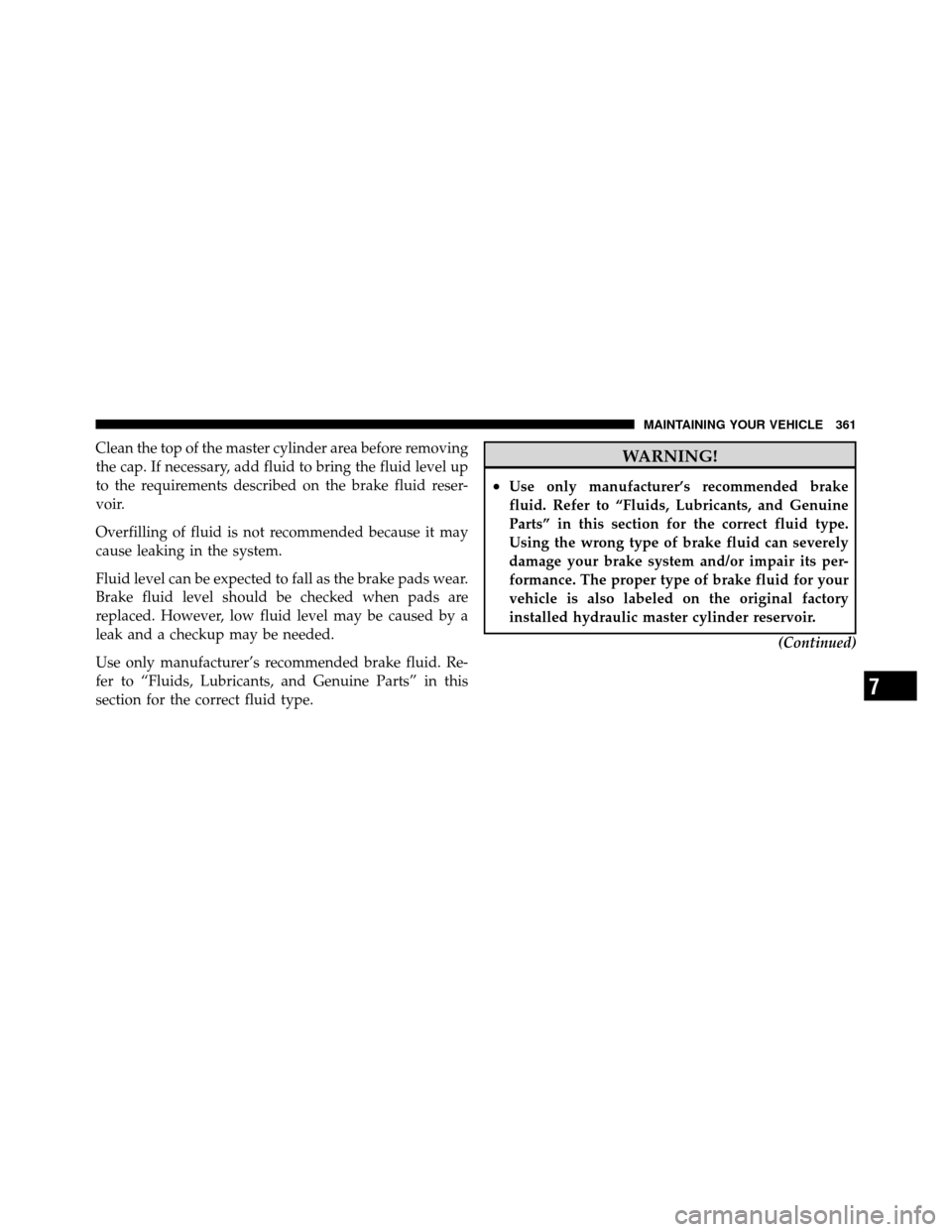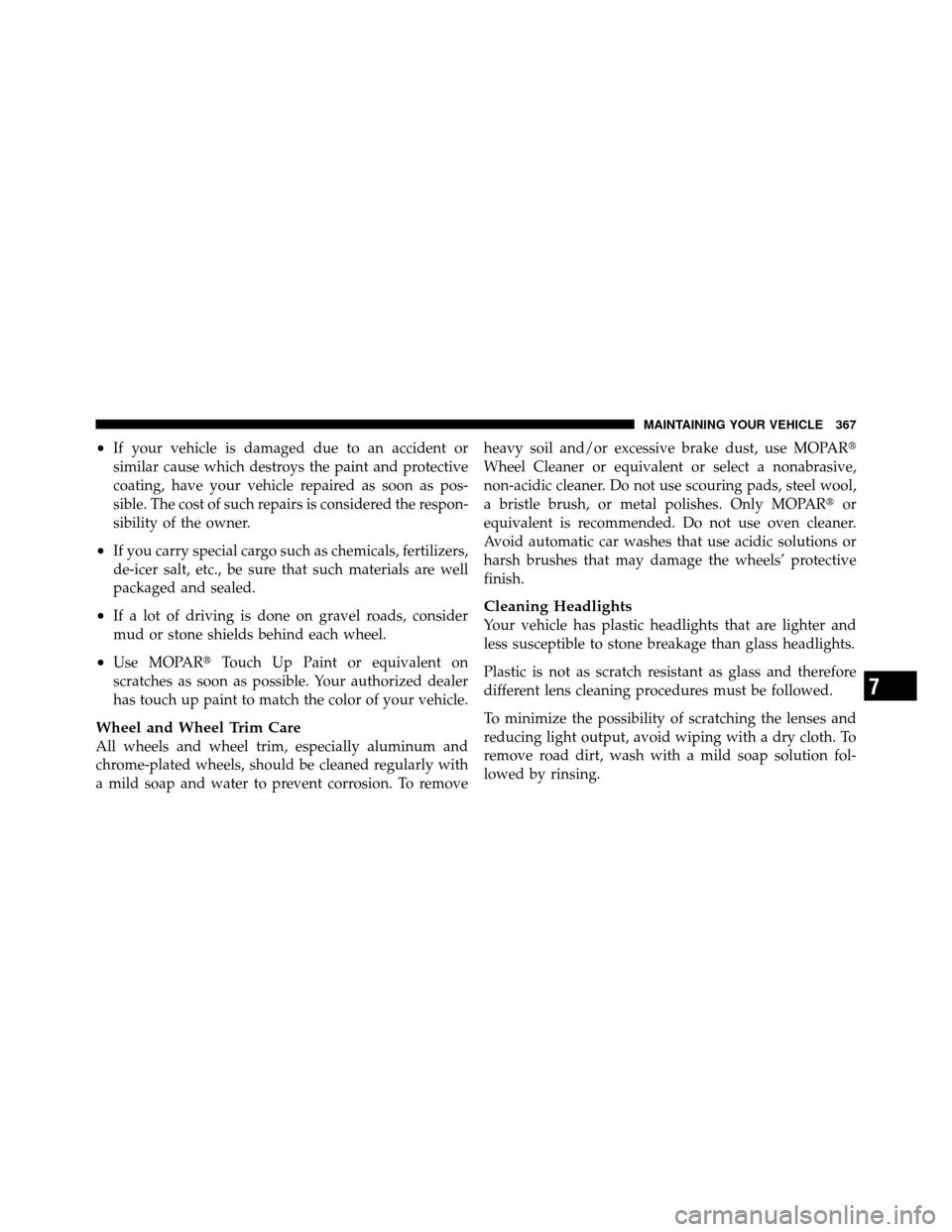Page 336 of 436
ENGINE COMPARTMENT — 2.7L
1 — Engine Coolant Reservoir7 — Power Distribution Center
2 — Coolant Pressure Cap 8 — Air Cleaner Filter
3 — Power Steering Fluid Reservoir 9 — Engine Oil Dipstick
4 — Automatic Transaxle Dipstick 10 — Engine Oil Fill
5 — Brake Fluid Reservoir 11 — Washer Fluid Reservoir
6 — Integrated Power Module
336 MAINTAINING YOUR VEHICLE
Page 337 of 436
ENGINE COMPARTMENT — 3.5L
1 — Engine Coolant Reservoir6 — Air Cleaner Filter
2 — Coolant Pressure Cap 7 — Engine Oil Dipstick
3 — Power Steering Fluid Reservoir 8 — Engine Oil Fill
4 — Brake Fluid Reservoir 9 — Washer Fluid Reservoir
5 — Power Distribution Center
7
MAINTAINING YOUR VEHICLE 337
Page 360 of 436

•Make sure that the radiator and coolant recovery
bottle overflow hoses are not kinked or obstructed.
•Keep the front of the radiator clean. If your vehicle is
equipped with air conditioning, keep the front of the
condenser clean.
•Do not change the thermostat for Summer or Winter
operation. If replacement is ever necessary, install
ONLY the correct type thermostat. Other designs may
result in unsatisfactory cooling performance, poor gas
mileage, and increased emissions.
Brake System
In order to assure brake system performance, all brake
system components should be inspected periodically.
Refer to the “Maintenance Schedule” in Section 8 for the
proper maintenance intervals.
WARNING!
Riding the brakes can lead to brake failure and
possibly an accident. Driving with your foot resting
or riding on the brake pedal can result in abnormally
high brake temperatures, excessive lining wear, and
possible brake damage. You would not have your full
braking capacity in an emergency.
Master Cylinder - Brake Fluid Level Check
Check the fluid level in the master cylinder immediately
if the brake system warning light indicates system fail-
ure.
Check the fluid level in the master cylinder when per-
forming underhood services.
360 MAINTAINING YOUR VEHICLE
Page 361 of 436

Clean the top of the master cylinder area before removing
the cap. If necessary, add fluid to bring the fluid level up
to the requirements described on the brake fluid reser-
voir.
Overfilling of fluid is not recommended because it may
cause leaking in the system.
Fluid level can be expected to fall as the brake pads wear.
Brake fluid level should be checked when pads are
replaced. However, low fluid level may be caused by a
leak and a checkup may be needed.
Use only manufacturer’s recommended brake fluid. Re-
fer to “Fluids, Lubricants, and Genuine Parts” in this
section for the correct fluid type.WARNING!
•Use only manufacturer’s recommended brake
fluid. Refer to “Fluids, Lubricants, and Genuine
Parts” in this section for the correct fluid type.
Using the wrong type of brake fluid can severely
damage your brake system and/or impair its per-
formance. The proper type of brake fluid for your
vehicle is also labeled on the original factory
installed hydraulic master cylinder reservoir.(Continued)
7
MAINTAINING YOUR VEHICLE 361
Page 362 of 436

WARNING! (Continued)
•To avoid contamination from foreign matter or
moisture, use only new brake fluid or fluid that
has been in a tightly closed container. Keep the
master cylinder reservoir cap secured at all times.
Brake fluid in a open container absorbs moisture
from the air resulting in a lower boiling point.
This may cause it to boil unexpectedly during hard
or prolonged braking, resulting in sudden brake
failure. This could result in a accident.
•Overfilling the brake fluid reservoir can result in
spilling brake fluid on hot engine parts, causing
the brake fluid to catch fire. Brake fluid can also
damage painted and vinyl surfaces, care should be
taken to avoid its contact with these surfaces.(Continued)
WARNING! (Continued)
•Do not allow petroleum based fluid to contami-
nate the brake fluid. Brake seal components could
be damaged, causing partial or complete brake
failure. This could result in an accident.
Automatic Transaxle
The automatic transaxle and differential assembly are
contained within a single housing.
The fluid level in the automatic transaxle should be
checked whenever the vehicle is serviced. Operation with
an improper fluid level will greatly reduce the life of the
transaxle and the fluid.
362 MAINTAINING YOUR VEHICLE
Page 363 of 436

Fluid Level Check — Vehicles with 2.4L and 2.7L
Engines
Use the following procedure to check the automatic
transaxle fluid level properly:
1. Park the vehicle on level ground.
2. Run the engine at curb idle speed for a minimum of
60 seconds.
3. Apply the parking brake fully.
4. Place the shift lever momentarily into each gear posi-
tion ending with the lever in PARK.
5. Wipe the area around the dipstick clean to eliminate
the possibility of dirt entering the transaxle.
6. Remove the dipstick and determine if the fluid is hot
or cold. Hot fluid is approximately 180°F (82° C), which
is the normal operating temperature after the vehicle isdriven at least 15 miles (24 km). Hot fluid cannot be held
comfortably between the fingertips. Cold fluid is at a
temperature below 80°F (27° C).
7. Wipe the dipstick clean and reinsert until seated. Then,
remove dipstick and note the reading.
a. If the fluid is hot, the reading should be in the
crosshatched area marked “HOT” (between the upper
two holes in the dipstick).
b. If the fluid is cold, the fluid level should be between
the lower two holes in the area marked “COLD.”
If the fluid level is low, add sufficient fluid through the
filler (dipstick) tube to bring it to the proper level. Do not
overfill.
7
MAINTAINING YOUR VEHICLE 363
Page 367 of 436

•If your vehicle is damaged due to an accident or
similar cause which destroys the paint and protective
coating, have your vehicle repaired as soon as pos-
sible. The cost of such repairs is considered the respon-
sibility of the owner.
•If you carry special cargo such as chemicals, fertilizers,
de-icer salt, etc., be sure that such materials are well
packaged and sealed.
•If a lot of driving is done on gravel roads, consider
mud or stone shields behind each wheel.
•Use MOPAR�Touch Up Paint or equivalent on
scratches as soon as possible. Your authorized dealer
has touch up paint to match the color of your vehicle.
Wheel and Wheel Trim Care
All wheels and wheel trim, especially aluminum and
chrome-plated wheels, should be cleaned regularly with
a mild soap and water to prevent corrosion. To remove heavy soil and/or excessive brake dust, use MOPAR�
Wheel Cleaner or equivalent or select a nonabrasive,
non-acidic cleaner. Do not use scouring pads, steel wool,
a bristle brush, or metal polishes. Only MOPAR�
or
equivalent is recommended. Do not use oven cleaner.
Avoid automatic car washes that use acidic solutions or
harsh brushes that may damage the wheels’ protective
finish.
Cleaning Headlights
Your vehicle has plastic headlights that are lighter and
less susceptible to stone breakage than glass headlights.
Plastic is not as scratch resistant as glass and therefore
different lens cleaning procedures must be followed.
To minimize the possibility of scratching the lenses and
reducing light output, avoid wiping with a dry cloth. To
remove road dirt, wash with a mild soap solution fol-
lowed by rinsing.
7
MAINTAINING YOUR VEHICLE 367
Page 372 of 436
CavityCartridge
Fuse Mini
Fuse Description
1 40 Amp
Green —Power Top Module
(If Equipped)
2— 20 Amp
Yellow AWD Module
3— 10 Amp
Red Battery Feed —
Center High
Mounted Stop
Light (CHMSL)/
Brake Switch
4— 10 Amp
Red Battery Feed — Ig-
nition Switch
5— 20 Amp
Yellow Trailer Tow — If
Equipped
6— 10 Amp
Red Ignition Off Draw
(IOD) — Power
Mirror Switch/
Climate ControlsCavity
Cartridge
Fuse Mini
Fuse Description
7— 30 Amp
Green Ignition Off Draw
(IOD) Sense 1
8— 30 Amp
Green Ignition Off Draw
(IOD) Sense 2
9 40 Amp
Green Battery Feed —
Power Seats - if
equipped/PZEV
Air Pump - if
equipped
10 —20 Amp
Yellow Battery Feed —
Cabin Compart-
ment Node (CCN)
11 —15 Amp
Lt Blue Selectable Power
Outlet
12 —20 Amp
Yellow —
372 MAINTAINING YOUR VEHICLE